Abstract
Antigenic competition between the Fc and Fab fragments of rabbit IgG in mice could be abolished by passive immunization with antiserum against the dominant antigen (Fc). The induction of tolerance to Fc also eliminated antigenic competition. Anti-Fd production, generally very poor in response to rabbit IgG, was considerably enhanced by these procedures, indicating that it is also subject to antigenic competition with Fc.
A model is proposed to explain antigenic competition which proposes that it is the `co-operative antibody' produced to the dominant antigen which acts as an inhibitor to antibody production to the suppressed antigen by competing for sites —presumably on macrophage membranes—where co-operation occurs.
The merits and difficulties of such an explanation are discussed.
Full text
PDF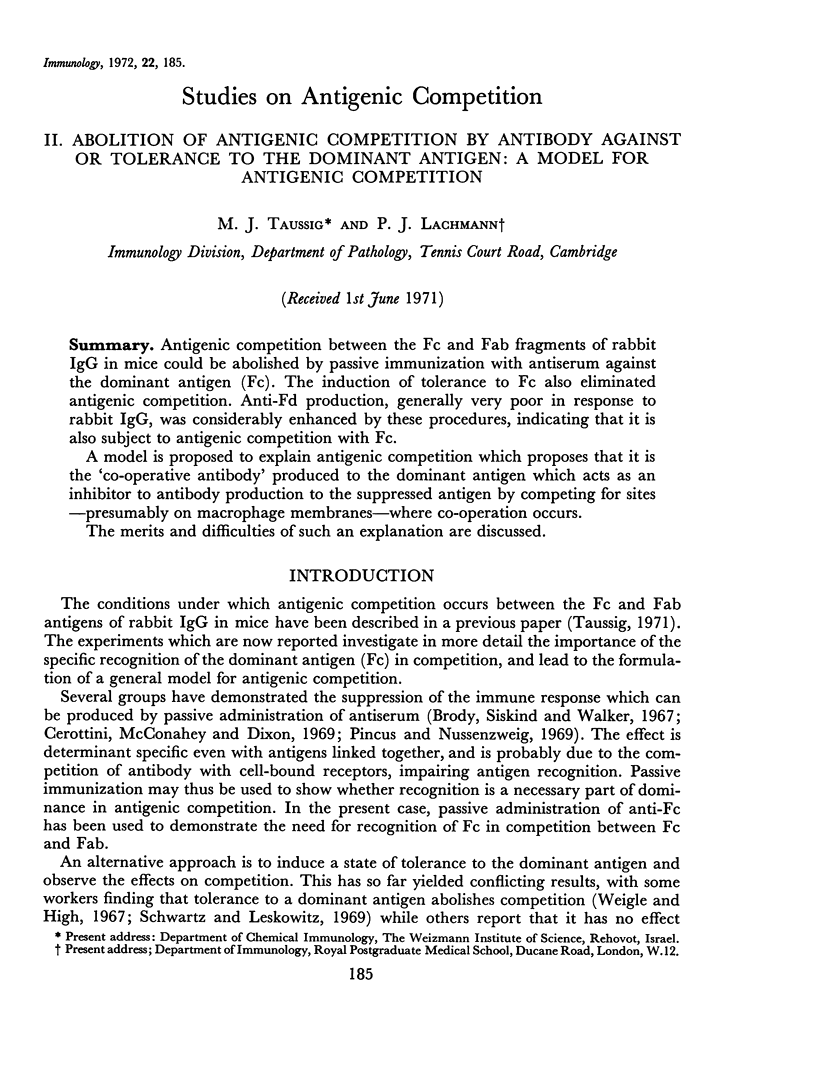
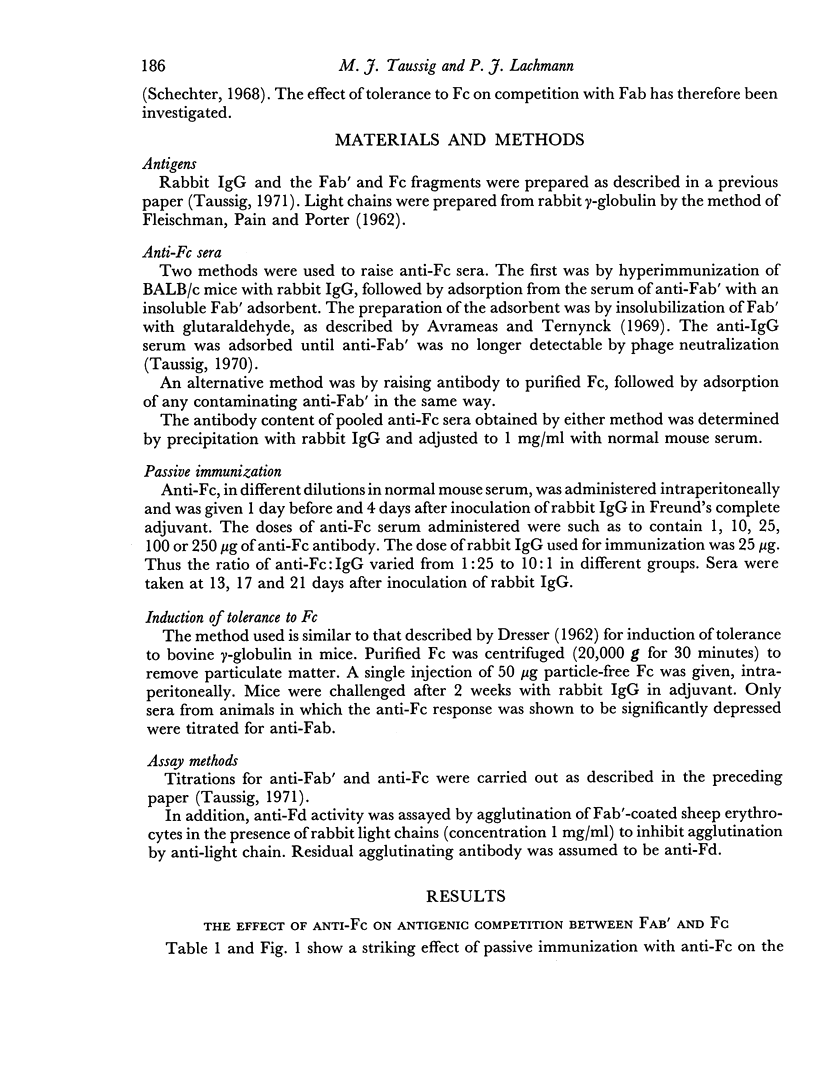
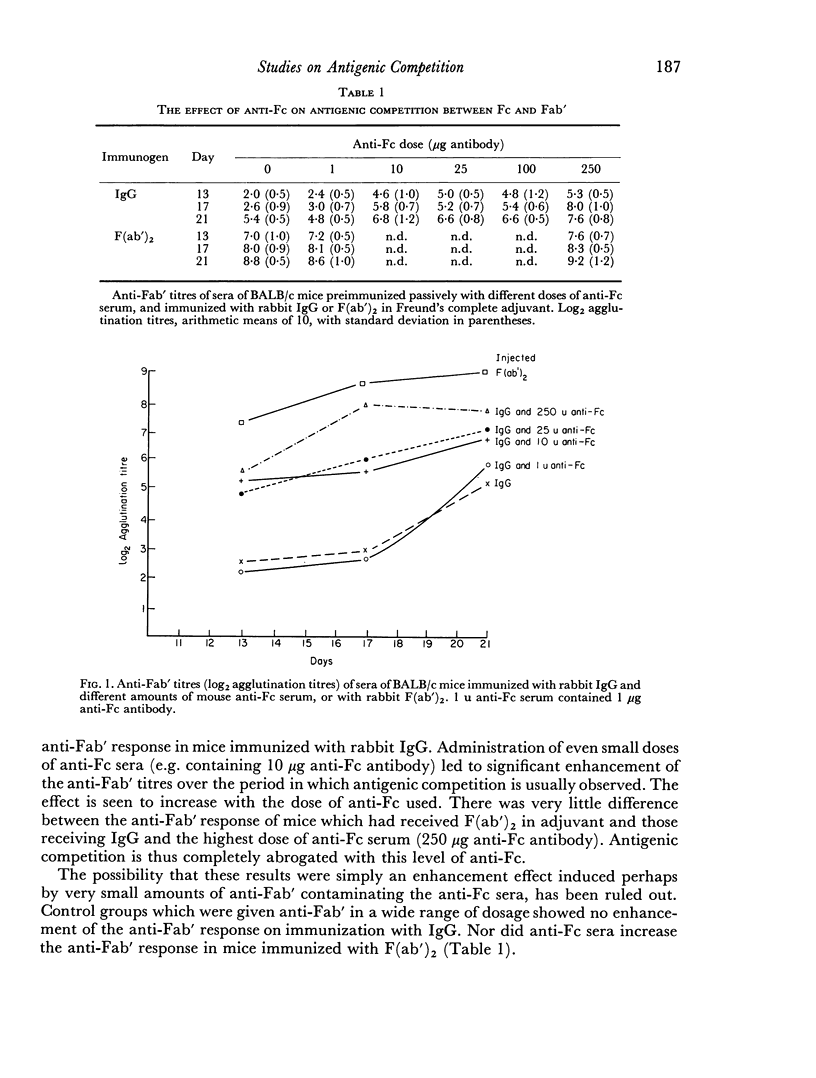
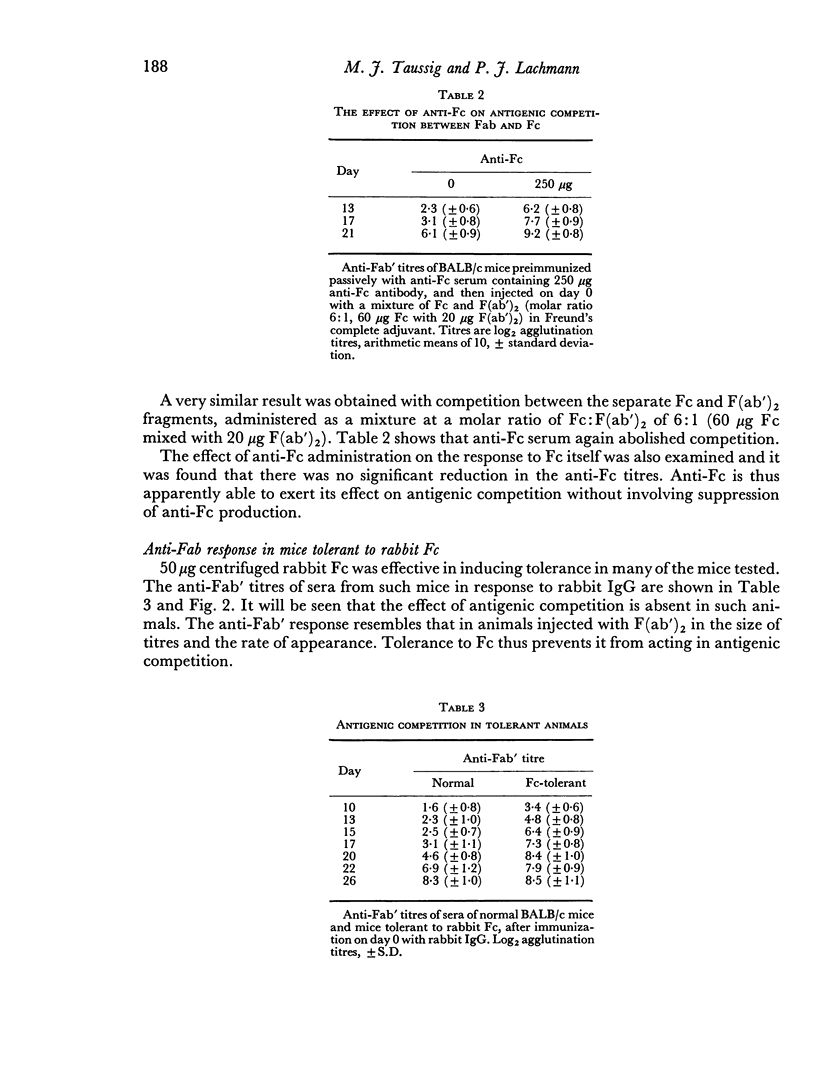
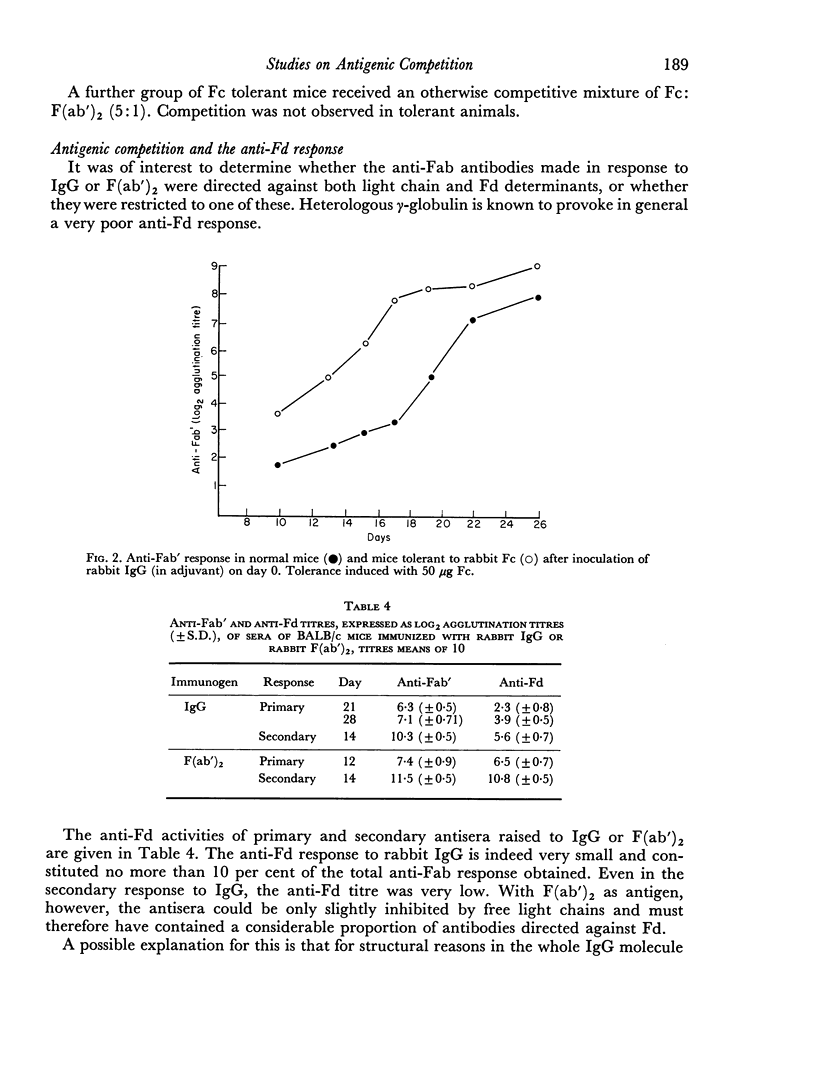
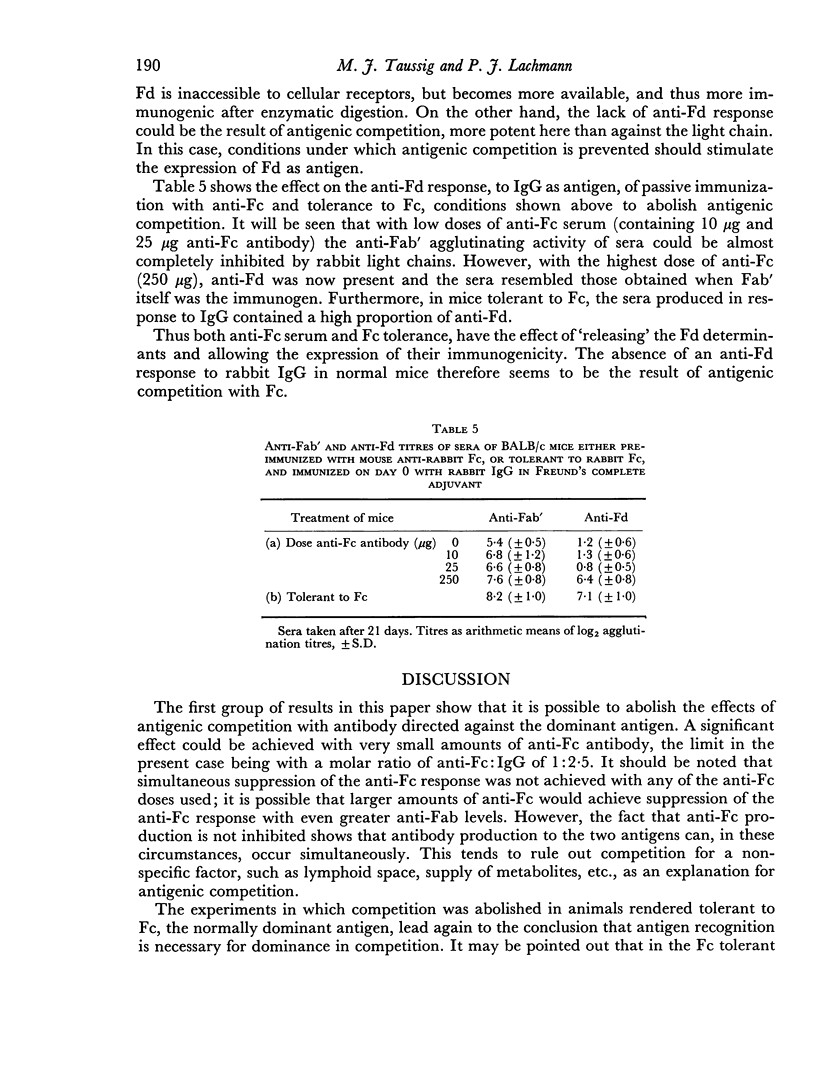
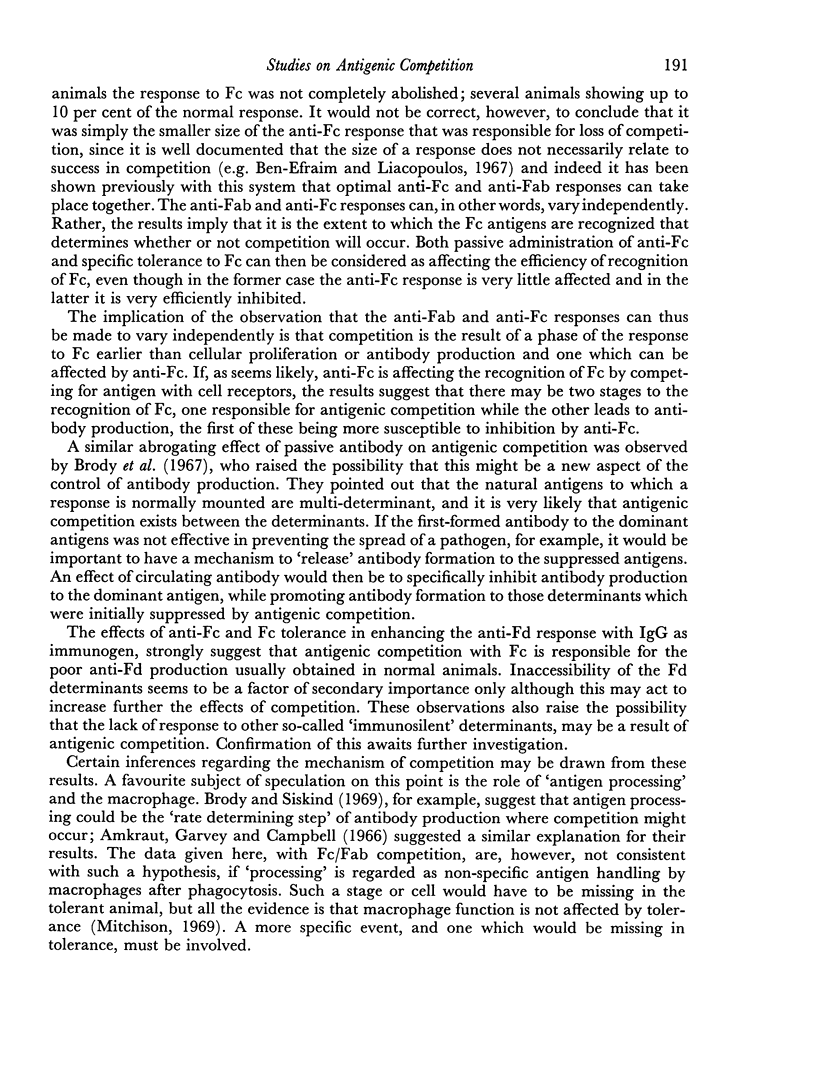
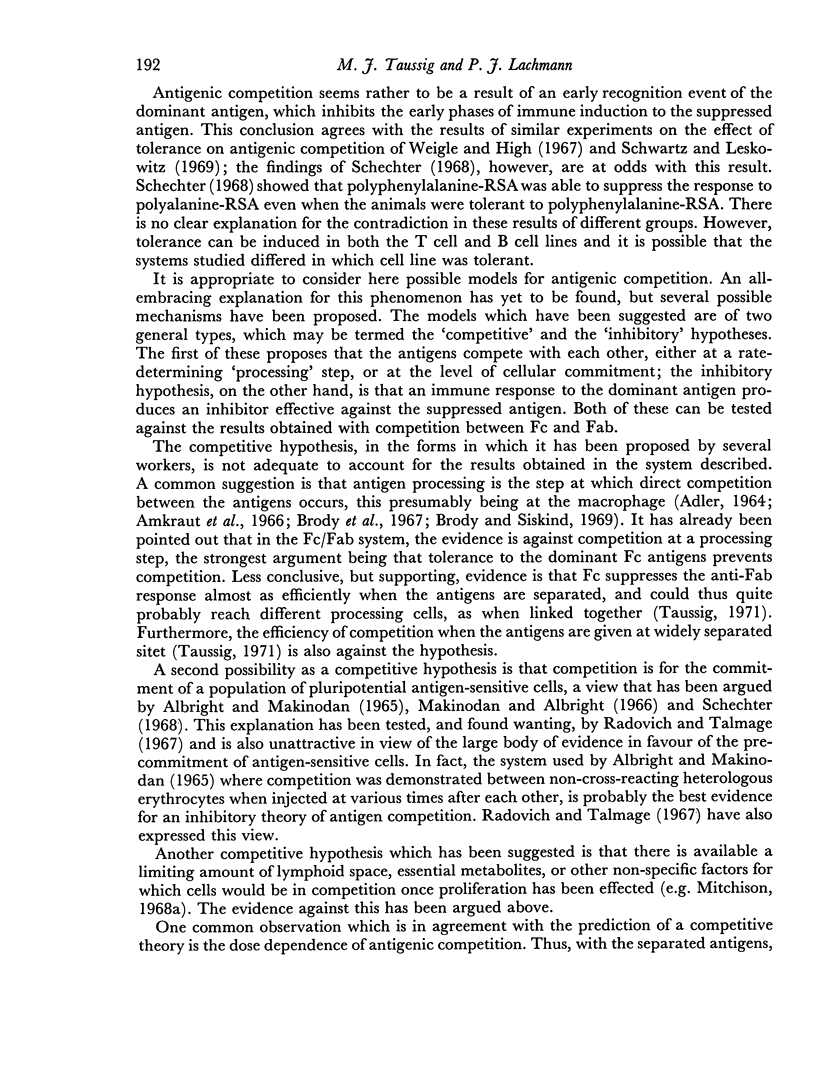
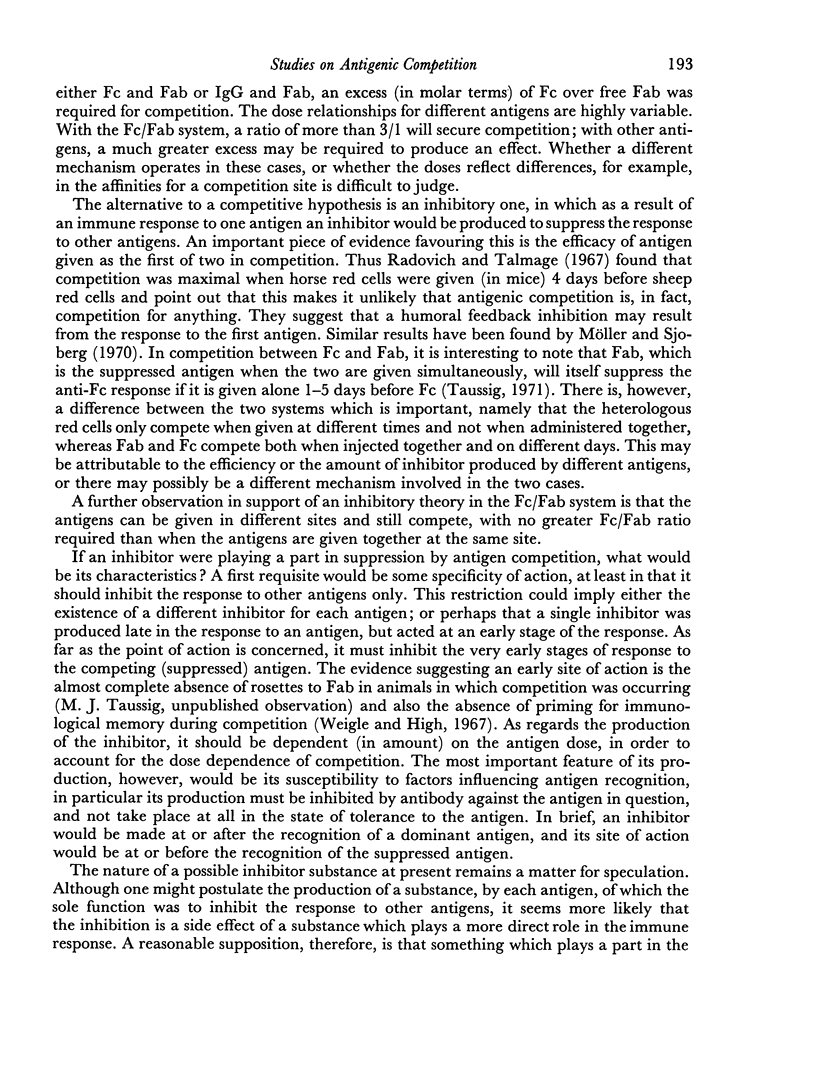
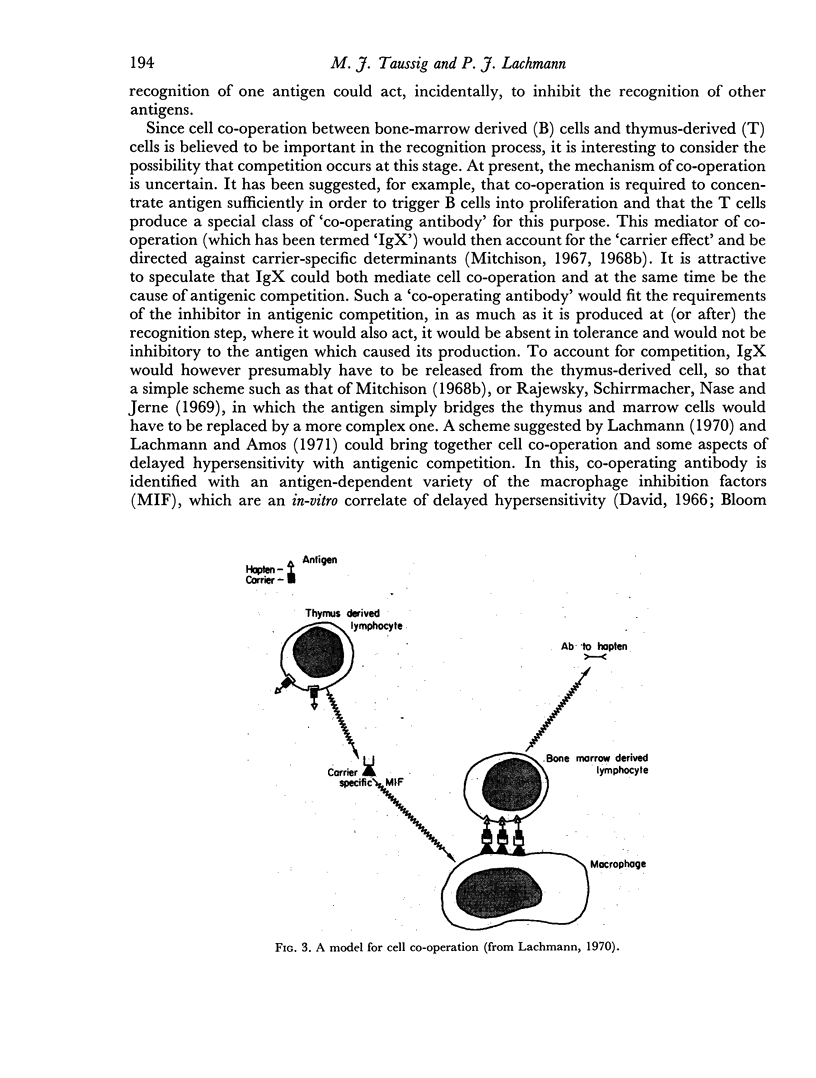
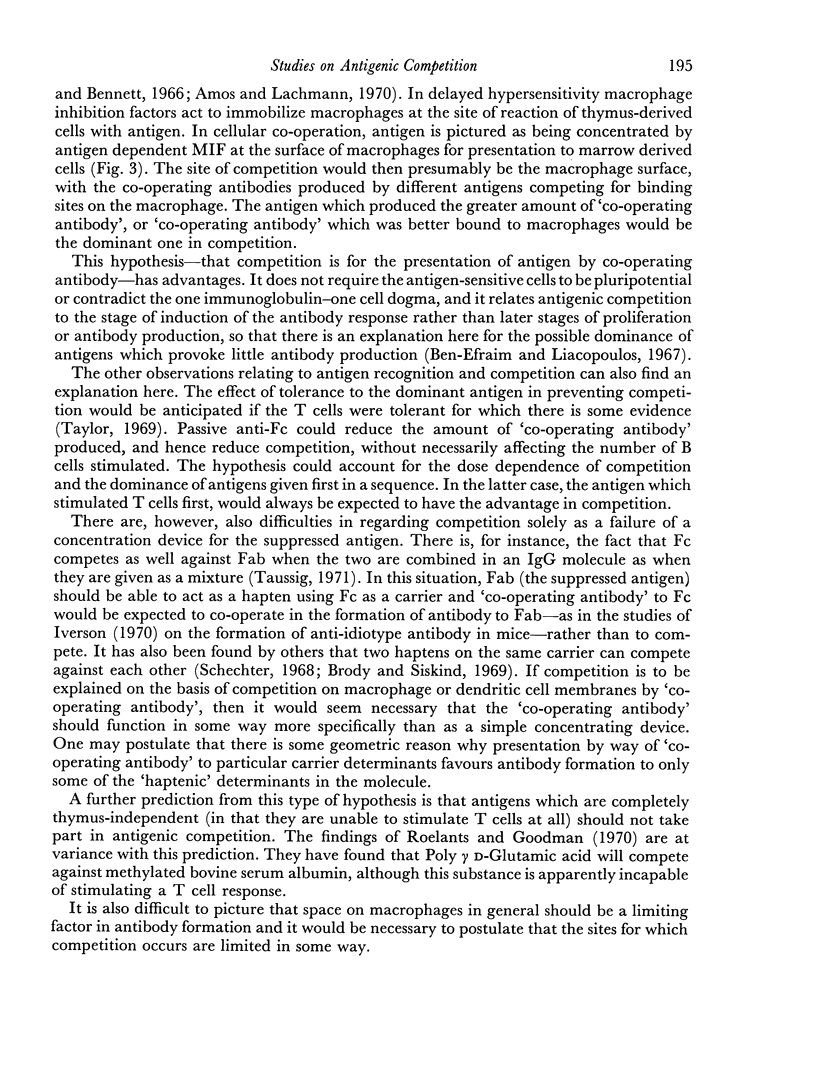
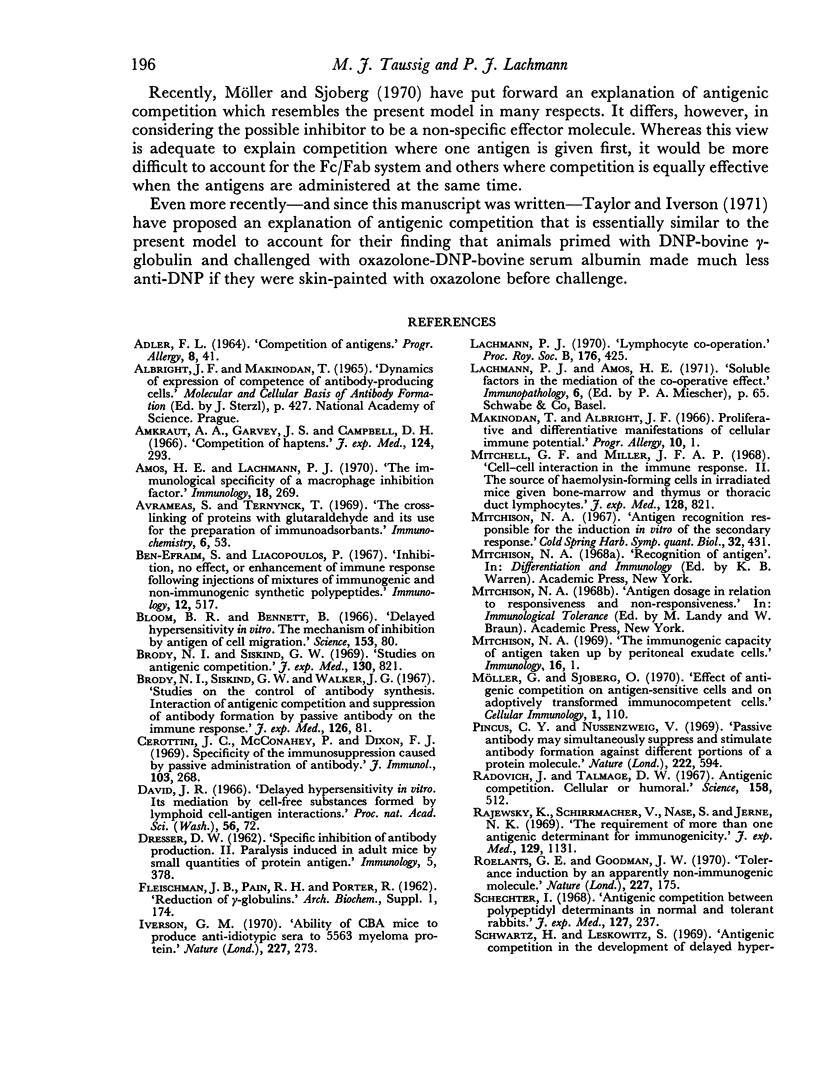
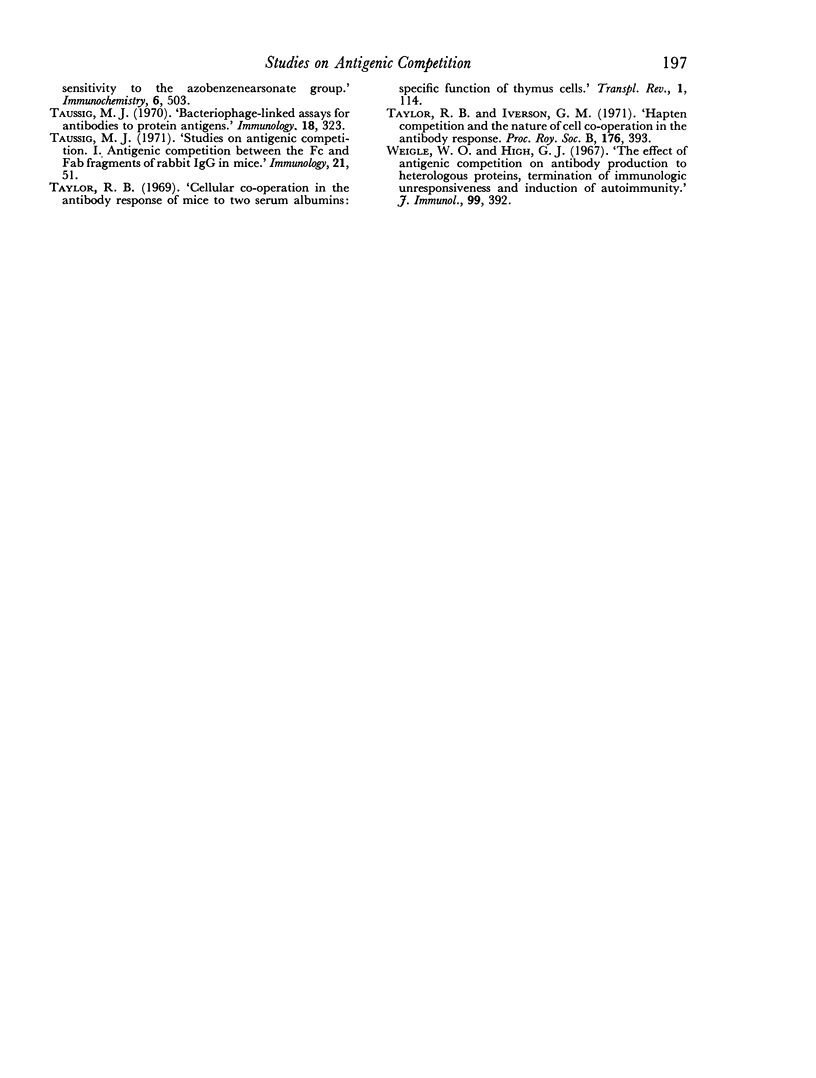
Selected References
These references are in PubMed. This may not be the complete list of references from this article.
- Amkraut A. A., Garvey J. S., Campbell D. H. Competition of haptens. J Exp Med. 1966 Sep 1;124(3):293–306. doi: 10.1084/jem.124.3.293. [DOI] [PMC free article] [PubMed] [Google Scholar]
- Amos H. E., Lachmann P. J. The immunological specificity of a macrophage inhibition factor. Immunology. 1970 Feb;18(2):269–278. [PMC free article] [PubMed] [Google Scholar]
- Avrameas S., Ternynck T. The cross-linking of proteins with glutaraldehyde and its use for the preparation of immunoadsorbents. Immunochemistry. 1969 Jan;6(1):53–66. doi: 10.1016/0019-2791(69)90178-5. [DOI] [PubMed] [Google Scholar]
- Ben-Efraim S., Liacopoulos P. Inhibition, no-effect or enhancement of immune responses following injection of mixtures of immunogenic and non-immunogenic synthetic polypeptides. Immunology. 1967 May;12(5):517–524. [PMC free article] [PubMed] [Google Scholar]
- Bloom B. R., Bennett B. Mechanism of a reaction in vitro associated with delayed-type hypersensitivity. Science. 1966 Jul 1;153(3731):80–82. doi: 10.1126/science.153.3731.80. [DOI] [PubMed] [Google Scholar]
- Brody N. I., Siskind G. W. Studies on antigenic competition. J Exp Med. 1969 Oct 1;130(4):821–832. doi: 10.1084/jem.130.4.821. [DOI] [PMC free article] [PubMed] [Google Scholar]
- Brody N. I., Walker J. G., Siskind G. W. Studies on the control of antibody synthesis. Interaction of antigenic competition and suppression of antibody formation by passive antibody on the immune response. J Exp Med. 1967 Jul 1;126(1):81–91. doi: 10.1084/jem.126.1.81. [DOI] [PMC free article] [PubMed] [Google Scholar]
- Cerottini J. C., McConahey P. J., Dixon F. J. Specificity of the immunosuppression caused by passive administration of antibody. J Immunol. 1969 Aug;103(2):268–275. [PubMed] [Google Scholar]
- DRESSER D. W. Specific inhibition of antibody production. II. Paralysis induced in adult mice by small quantities of protein antigen. Immunology. 1962 May;5:378–388. [PMC free article] [PubMed] [Google Scholar]
- David J. R. Delayed hypersensitivity in vitro: its mediation by cell-free substances formed by lymphoid cell-antigen interaction. Proc Natl Acad Sci U S A. 1966 Jul;56(1):72–77. doi: 10.1073/pnas.56.1.72. [DOI] [PMC free article] [PubMed] [Google Scholar]
- FLEISCHMAN J. B., PAIN R. H., PORTER R. R. Reduction of gamma-globulins. Arch Biochem Biophys. 1962 Sep;Suppl 1:174–180. [PubMed] [Google Scholar]
- Iverson G. M. Ability of CBA mice to produce anti-idiotypic sera to 5563 myeloma protein. Nature. 1970 Jul 18;227(5255):273–274. doi: 10.1038/227273a0. [DOI] [PubMed] [Google Scholar]
- Lachmann P. J. Lymphocyte cooperation. Proc R Soc Lond B Biol Sci. 1971 Jan 12;176(1045):425–426. doi: 10.1098/rspb.1971.0005. [DOI] [PubMed] [Google Scholar]
- Makinodan T., Albright J. F. Proliferative and differentiative manifestations of cellular immune potential. Prog Allergy. 1967;10:1–36. [PubMed] [Google Scholar]
- Mitchell G. F., Miller J. F. Cell to cell interaction in the immune response. II. The source of hemolysin-forming cells in irradiated mice given bone marrow and thymus or thoracic duct lymphocytes. J Exp Med. 1968 Oct 1;128(4):821–837. doi: 10.1084/jem.128.4.821. [DOI] [PMC free article] [PubMed] [Google Scholar]
- Mitchison N. A. The immunogenic capacity of antigen taken up by peritoneal exudate cells. Immunology. 1969 Jan;16(1):1–14. [PMC free article] [PubMed] [Google Scholar]
- Möller G., Sjöberg O. Effect of antigenic competition on antigen-sensitive cells and on adoptively transferred immunocompetent cells. Cell Immunol. 1970 May;1(1):110–121. doi: 10.1016/0008-8749(70)90064-x. [DOI] [PubMed] [Google Scholar]
- Pincus C. S., Nussenzweig V. Passive antibody may simultaneously suppress and stimulate antibody formation against different portions of a protein molecule. Nature. 1969 May 10;222(5193):594–596. doi: 10.1038/222594a0. [DOI] [PubMed] [Google Scholar]
- Radovich J., Talmage D. W. Antigenic competition: cellular or humoral. Science. 1967 Oct 27;158(3800):512–514. doi: 10.1126/science.158.3800.512. [DOI] [PubMed] [Google Scholar]
- Rajewsky K., Schirrmacher V., Nase S., Jerne N. K. The requirement of more than one antigenic determinant for immunogenicity. J Exp Med. 1969 Jun 1;129(6):1131–1143. doi: 10.1084/jem.129.6.1131. [DOI] [PMC free article] [PubMed] [Google Scholar]
- Roelants G. E., Goodman J. W. Tolerance induction by an apparently non-immunogenic molecule. Nature. 1970 Jul 11;227(5254):175–176. doi: 10.1038/227175a0. [DOI] [PubMed] [Google Scholar]
- Schechter I. Antigenic competition between polypeptidyl determinants in normal and tolerant rabbits. J Exp Med. 1968 Feb 1;127(2):237–250. doi: 10.1084/jem.127.2.237. [DOI] [PMC free article] [PubMed] [Google Scholar]
- Schwartz H., Leskowitz S. Antigenic competition in the development of delayed hypersensitivity to the azobenzenearsonate group. Immunochemistry. 1969 May;6(3):503–506. doi: 10.1016/0019-2791(69)90311-5. [DOI] [PubMed] [Google Scholar]
- Taussig M. J. Bacteriophage linked assays for antibodies to protein antigens. Immunology. 1970 Mar;18(3):323–330. [PMC free article] [PubMed] [Google Scholar]
- Taussig M. J. Studies on antigenic competition. I. Antigenic competition between the Fc and Fab fragments of rabbit IgG in mice. Immunology. 1971 Jul;21(1):51–60. [PMC free article] [PubMed] [Google Scholar]
- Taylor R. B. Cellular cooperation in the antibody response of mice to two serum albumins: specific function of thymus cells. Transplant Rev. 1969;1:114–149. doi: 10.1111/j.1600-065x.1969.tb00138.x. [DOI] [PubMed] [Google Scholar]
- Taylor R. B., Iverson G. M. Hapten competition and the nature of cell-cooperation in the antibody response. Proc R Soc Lond B Biol Sci. 1971 Jan 12;176(1045):393–418. doi: 10.1098/rspb.1971.0003. [DOI] [PubMed] [Google Scholar]
- Weigle W. O., High G. J. The effect of antigenic competition on antibody production to heterologous proteins, termination of immunologic unresponsiveness and induction of autoimmunity. J Immunol. 1967 Aug;99(2):392–398. [PubMed] [Google Scholar]


